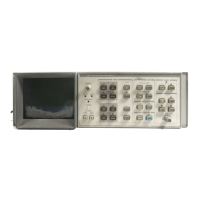Control Gate Amplifier @
The current to voltage amplifier output stage for the Z Axis amplifier is similar in concept
to the one used in the X and Y Current to Voltage Amplifiers. There are some significant
differences in the input stages however. The active load current source is formed by Q301,
R301,
R302, and R305. The emitter of Q303 is at a fixed dc level of three base-emitter
junction voltages above ground (approximately 1.8 V). R302 and R305 develop a fixed dc
voltage at the base of
Q301
and thus establish a fixed dc current in the emitter resistor, R301.
The emitter current translates into a fixed dc collector current source acting as a pullup for
the output node. Q302 acts as a common emitter pull down for the output node. Q304 is an
emitter follower driver for Q302 giving a large open-loop current gain in the pull-down half of
the amplifier. R307 is the feedback resistor that determines the closed loop current to voltage
gain of the stage. Q303 provides the dc bias path for Q301, Q302, and Q304, and also acts
as an ac feed forward amplifier to improve the transient response of the amplifier both by
modulating the current source load, Q301, and the pull down stage, Q302.
C307 is used to provide a zero in the feedback path to compensate the high frequency
response of the amplifier. R308 and C304 are also used to adjust the high frequency response.
These two adjustments are used to optimize the step response of the amplifier when the
blanking signal is switched on and off. The rising edge is adjusted for best rise time without
overshoot. Any overshoot shows up as intensity modulation at the beginning of a vector. The
falling edge is not as critical for overshoot because the beam is off. Both rise and fall times
are critical because if they are too
slow,
vectors will have tails as the beam moves during the
transition time or there will be gaps between vectors that are supposed to be continuous lines.
Typically this design yields rise and fall times of 40 ns in response to the blank signal. The
rise and fall times for the brightness signal are about 150 ns. This signal path includes the
op amp stages U101B and U101D which determine the response time. The brightness signal
has one microsecond to settle between each vector so this signal path is much faster than the
signal that it needs to carry.
Focus Controls ©, (6), (f),
(G)
The focus control section consists of a dc focus voltage that is established by the A1A3 board
and the Focus Gate signal that is generated by the A1A2 board. The focus gate signal is
composed of four separate input terms fed to a virtual ground summing node at the input of a
current to voltage amplifier. The output of this amplifier is coupled onto the dc focus voltage
generated on the A1A3 board and applied to the focus electrode of the CRT.
The four focus terms are the intensity correction, front panel FOCUS and correction for the
curvature of focus field, top/bottom and right/left. The Focus Gate Amplifier © is nearly
identical to the Control Gate Amplifier
(R)
except the high frequency compensation of the
focus amplifier is not adjustable and CR404 and CR405 were added to bring the summing
node voltage down to 0 V so that the top/bottom and left/right adjustment attenuators could
be referenced to ground.
Focus must be corrected for beam intensity. The focus voltage needs to be made more
negative as the beam current increases. This is done by taking the intensity signal from
U401B (D and feeding it to a variable gain stage formed by U401C, R409, R410, and R411.
This amplifier has an adjustable gain of from zero to approximately three. With Z axis signals
of zero to two volts this gives a maximum of minus six volts output from U401C. R412 (511
fi) translates this voltage into approximately 12 mA maximum. This would translate to
over 140 V correction at the Focus Gate output if the FOCUS COMP pot, R409 were set to
A1A2 5

